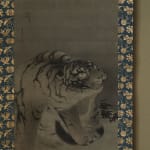Maruyama Ōkyo (1733−1795)
Tiger and Dragon
Ink and light color on silk, pair of hanging scrolls
1770
Seals: Okyo no in, Chusen (each)
106.5 x 50 cm each
197 x 64.5 cm each (overall)
Further images
Outlines are barely visible here. Maruyuma Okyo once said, “There should be less contours.” Object itself has no outlines. As Vasari frequently criticized those ugly lines in the Byzantine painting, these are an obstacle to naturalism. In the dragon painting of the present work, the dragon and the clouds are so deftly painted with the gradations of ink; the clouds, colored paler than the ground paper, prossessing a tactile texture, and the dragon appears to submerge into the darkness naturally. Most likely this dragon painting is a forerunner of the folding-screen masterpiece Dragon and Clouds (Important Cultural Property; currently in private collection). The bamboo leaves in the background of the tiger painting, drawn in the thick ink, display lineage to the orthodox dragon-and-tiger painting. The tiger’s furry body is depicted through repeating fine brushstrokes, known as kegaki, a long-established technique in Japan. Its realistic pattern of the stripes shows that Okyo made his careful observation to the real skin of a tiger. The cat-like large eyes suggest that Okyo never witnessed a living one.
Most of Okyo’s tigers take the pose of sitting with their forelegs upright and facing towards the viewer. Such a posture easily fits into the oblong format of hanging scroll, hence Okyo’s tiger paintings are commonly produced in vertical. The tiger in the present work is so close to the viewer that it is as if to jump out of the frame. Such an expression is probably derived from megane-e painting, a painting for use in an optical viewing device, in which the vanishing point is usually placed in the center and directly faces the viewer’s eyes.
Maruyama Okyo (painter; 1733−1795)
Also known as Sensai; Chusen; Issho; Kaun; Senrei; Mondo
Tamba-born late Edo period painter and the progenitor of the Maruyama School. Learned the Kano School painting technique under Ishida Yutei. Remarkably integrated the Song and Yuan dynasties painting techniques and the Western perspective method into Yutei’s shasei (direct observation from life) technique, and formed his distinctive style. Excelled at animal and botanical shasei paintings.
Most of Okyo’s tigers take the pose of sitting with their forelegs upright and facing towards the viewer. Such a posture easily fits into the oblong format of hanging scroll, hence Okyo’s tiger paintings are commonly produced in vertical. The tiger in the present work is so close to the viewer that it is as if to jump out of the frame. Such an expression is probably derived from megane-e painting, a painting for use in an optical viewing device, in which the vanishing point is usually placed in the center and directly faces the viewer’s eyes.
Maruyama Okyo (painter; 1733−1795)
Also known as Sensai; Chusen; Issho; Kaun; Senrei; Mondo
Tamba-born late Edo period painter and the progenitor of the Maruyama School. Learned the Kano School painting technique under Ishida Yutei. Remarkably integrated the Song and Yuan dynasties painting techniques and the Western perspective method into Yutei’s shasei (direct observation from life) technique, and formed his distinctive style. Excelled at animal and botanical shasei paintings.









